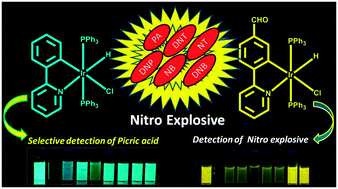Highly sensitive explosive sensing by “aggregation induced phosphorescence” active cyclometalated iridium(iii) complexes†
Abstract
Two phosphorescent complexes [Ir(o-CHOppy)(PPh3)2(H)Cl] (1) and [Ir(ppy)(PPh3)2(H)Cl] (2) exhibiting ‘aggregation induced phosphorescent emission (AIPE)’ properties have been found to be very sensitive to the detection of picric acid (PA). The detection limit for PA has been checked and was found to be 264 nM and 65 nM for complexes 1 and 2, respectively.


 Please wait while we load your content...
Please wait while we load your content...